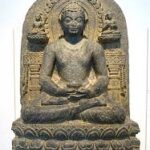
Buddhist Peace symbol
| Symbol | Buddhist Peace |
| Religion | Buddhism |
| Origin | Derived from ancient Indian symbols, particularly in Buddhist traditions |
| Meaning | Represents peace, enlightenment, and the path to Nirvana. |
| Appearance | Circular with various intricate symbols, often featuring the Dharma Wheel. |
| Colors | Typically incorporates calming colors like blue, white, or gold. |
| Usage | Employed in meditation, rituals, and as a universal symbol of peace. |
| History | Traces back to ancient Buddhist teachings, gaining prominence globally in the 20th century. |
| Popularity | Widely recognized and embraced as a symbol of peace. |
| Importance | Signifies the Buddhist principles of compassion, mindfulness, and non-violence. |
| Complexity | Intricate design reflects the depth and complexity of Buddhist philosophy. |
| Emotions | Evokes feelings of serenity, harmony, and spiritual growth. |
While the most recognizable symbol associated with Buddhist peace might be the swastika, it’s important to remember its complex history and varied interpretations.
The Swastika:
- In Buddhism, the swastika, known as “manji,” represents the Buddha’s auspicious footprints or his teachings.
- It’s typically left-facing, unlike the Nazi symbol, and holds positive connotations like good luck and spiritual well-being.
- However, due to the symbol’s appropriation by hate groups, its public display can be sensitive and misunderstood.
Beyond the Swastika:
- Numerous other symbols embody Buddhist peace concepts:
- The Dharmachakra (Wheel of Dharma): Represents the Buddha’s teachings and the cycle of life, death, and rebirth.
- The Lotus Flower: Symbolizes enlightenment and spiritual growth emerging from muddy beginnings.
- The Bodhi Tree: Where the Buddha attained enlightenment,signifying wisdom and inner peace.
Remember:
- When discussing Buddhist peace symbols, be mindful of the swastika’s baggage and use it with caution.
- Explore the rich tapestry of other Buddhist symbols that represent peace and enlightenment.